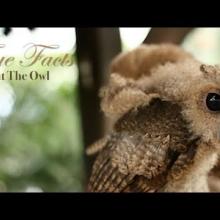

Join BirdNote tomorrow, November 30th!
Illustrator David Sibley and actor H. Jon Benjamin will face off in the bird illustration battle of the century during BirdNote's Year-end Celebration and Auction!
This Northern Pygmy-Owl appears to have eyes in the back of its head. But why? One theory is that large false eyes may create the illusion that the owl is much bigger than its 6 and 3/4-inch size. A more current theory is that the false eyes help protect the pygmy-owl's true eyes. Small birds will mob this diurnal owl, even striking it, directing some attacks at its eyes. If the large false eyes can take the brunt of these attacks, little harm will come to the Pygmy-Owl's vulnerable true eyes.
Support for BirdNote comes from the Cornell Lab’s Bird Academy, with online courses that share the wonder and joy of birds. More at AllAboutBirds.org.
BirdNote®
Pygmy-Owls’ False Eyes
Written by Bob Sundstrom
This is BirdNote.
[Sound of grade-school children]
Back in grade school, we all likely had a teacher with an uncanny ability, even with her back turned, to sense when we were up to no good. You might say she had eyes in the back of her head.
In nature, there are a few birds that actually appear to have eyes in the back of their heads. Birds like the Northern Pygmy-Owl have large, black, eye-shaped markings on the feathered back of their brown heads — a plumage adaptation that creates a pair of false eyes. [Northern Pygmy-Owl hoots]
But why? One theory is that large false eyes may deter predators — they create the illusion that the pygmy-owl is much bigger than its 6¾-inch, [2½-ounce] size. [Northern Pygmy-Owl hoots]
A more current theory is that the false eyes help protect the pygmy-owl’s true eyes. The little owl, which is active during daylight, is often subject to aggressive mobbing. Small birds will surround, scold, and even strike the pygmy-owl, with some attacks directed at its eyes. [Mobbing sounds of Red-breasted Nuthatch, Black-capped Chickadees and American Robins.] If the large false eyes can take the brunt of these attacks, little harm will come to the owl’s vulnerable true eyes. [Northern Pygmy-Owl hoots]
There's always more to the story, at BirdNote.org. I’m Mary McCann.
Support for BirdNote comes from the Cornell Lab’s Bird Academy, with online courses that share the wonder and joy of birds. More at AllAboutBirds.org.
###
Sounds of the birds provided by The Macaulay Library of Natural Sounds at the Cornell Lab of Ornithology, Ithaca, New York. Northern Pygmy-Owl recorded by G.A. Keller; Black-capped Chickadees by R.C. Stein; American Robin by R.S. Little; Red-breasted Nuthatch by W.L. Hershberger.
BirdNote’s theme music was composed and played by Nancy Rumbel and John Kessler.
Producer: John Kessler
Executive Producer: Chris Peterson
© 2015 Tune In to Nature.org November 2013/2017/2020 Narrator: Mary McCann
ID# NOPO-02-2011-11-03
For background on pygmy-owl false eyes, see Geoffrey E. Hill’s Bird Coloration, Washington, D.C.: National Geographic Society: 2010.






